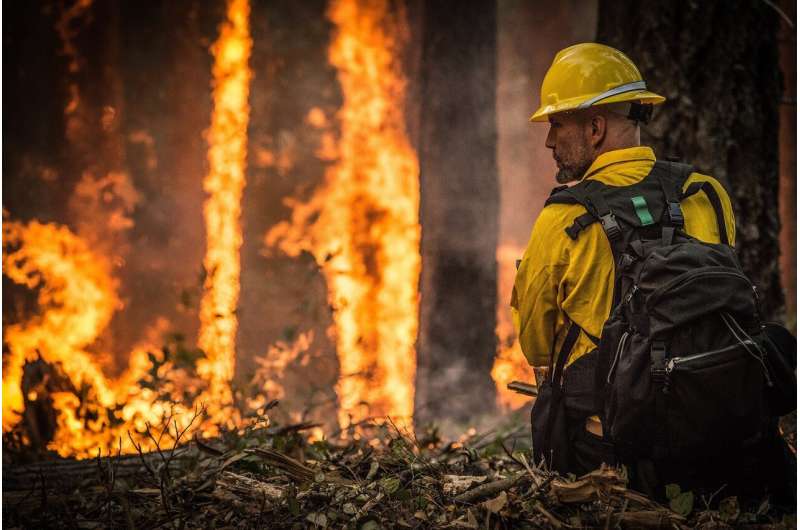
Evidence suggests that several of the catastrophic wildfires that struck Los Angeles earlier this year may have been sparked by electric utility infrastructure. As utilities prepare for record infrastructure demand driven by electrification, data centers, and renewables, the cost of inaction in the face of rising wildfire risk is mounting.
Wildfires can cause billions of dollars in damages to communities, bankrupt utilities, and ultimately drive up rates for customers. A new report from Stanford University’s Climate and Energy Policy Program (CEPP) offers a clearer view of where risk is greatest—and where mitigation is falling short.
“This isn’t just about power lines and vegetation,” said Michael Mastrandrea, research director at CEPP and a senior research scholar at the Stanford Woods Institute for the Environment. “It’s about protecting homes, communities, and the integrity of our energy system in a changing world.”
The Stanford researchers examined how investor-owned utilities (IOUs) across the country are confronting the escalating threat of wildfires. The key takeaway: while progress has been made across many Western states, utilities in some potentially high-risk areas remain underprepared.
Using a combination of public data and wildfire hazard modeling, the research team assigned “tiers” to utility wildfire mitigation efforts. Tier 1 utilities have implemented comprehensive plans and technical measures—like fast-trip settings that can turn power lines off more quickly when an object touches them during high-fire-risk periods—to reduce the chance of ignitions. Tier 3 utilities, on the other hand, lack even a public plan describing their implementation of wildfire mitigation or safety shutoffs.
While utilities in California, Oregon, and Utah tend to cluster in Tier 1, many in the Southeast, Gulf Coast, and Upper Midwest remain at Tier 3, according to the paper. The researchers note that this uneven progress is partly due to regulatory barriers in states with less recent catastrophic wildfire history. In such places, concerns about affordability and reliability often outweigh momentum for fire safety upgrades—until disaster strikes.
The report also underscores how emerging legal trends are putting utilities on notice. Recent lawsuits tied to wildfires in Oregon and Hawaii suggest that utilities nationwide may be held accountable for not proactively cutting power or upgrading equipment when conditions demand it. The Los Angeles wildfires exposed a critical blind spot, according to the researchers: Most wildfire mitigation plans focus on lower-voltage distribution lines, while higher-voltage transmission lines and deactivated infrastructure may be overlooked.
“We can’t afford to focus only on part of the problem,” said report lead author Eric Macomber, a wildfire legal fellow at CEPP and the Stanford Law School’s Environmental and Natural Resources Law and Policy Program. “We need wildfire planning that looks at the entire grid—public and private, active and inactive.”
To evaluate risk more accurately, the Stanford team used a model developed by the U.S. Forest Service (USFS). Unlike tools based solely on historical data, the USFS model incorporates climate conditions, vegetation, and topography to identify areas where severe wildfires are likely in the future. Overlaying utility service territories with USFS wildfire hazard maps allowed the team to visualize which utilities face the greatest threat.
Their analysis found that some IOUs with large portions of territory in potentially high-risk zones had made little or no progress on wildfire planning. The Stanford analysis framework also tracks whether utilities have implemented key mitigation elements, such as weather monitoring and programs to reduce harm to customers affected by planned shutoffs.
“The Forest Service maps helped us understand the wildfire hazards in these utilities’ territories,” said report co-author Avery Bick, a data science fellow in the Environmental Natural Resources Law and Policy Program. “More open data on power lines would help to refine risk assessments even more.”
The white paper builds on ongoing CEPP work to assess and meet wildfire-related challenges facing U.S. utilities. A previous report reviewed wildfire risk exposure and mitigation planning for Western U.S. electric utilities as of the 2024 wildfire season. The researchers hope to continue to expand and refine their methodology.
More information:
Current report: drive.google.com/file/d/1qpGkL … uYKUmIfdnL8eYRs/view
Previous report: stanford.io/4b8zFbh
Citation:
Fire-ready? Report finds many US power utilities unprepared for wildfire risk (2025, June 10)
retrieved 10 June 2025
from
This document is subject to copyright. Apart from any fair dealing for the purpose of private study or research, no
part may be reproduced without the written permission. The content is provided for information purposes only.













Leave a comment